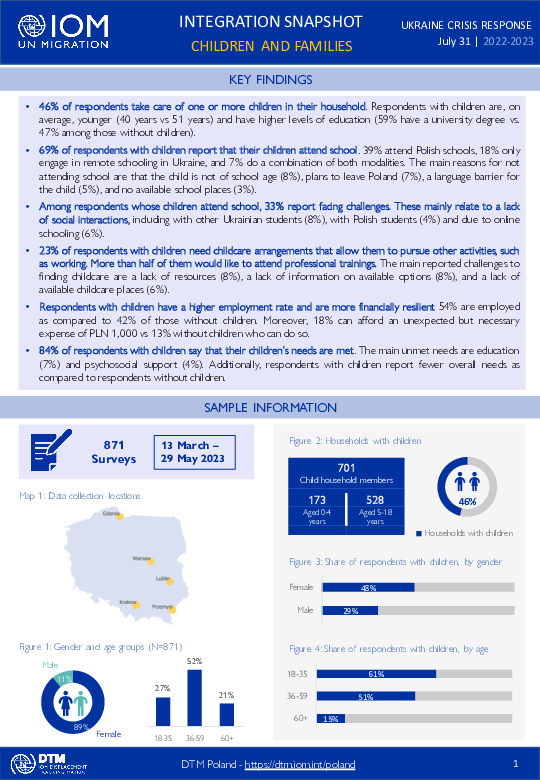-
Countries
-
Data and Analysis
-
Special Focus
-
Crisis Responses
Poland — Integration Snapshot: Children and Families (July 2023)

Contact
DTM Europe, DTMMediterranean@iom.int
Language
English
Location
Poland
Period Covered
Mar 13 2023
May 29 2023
Activity
- Survey
Key Findings:
• 46% of respondents take care of one or more children in their household. Respondents with children are, on average, younger (40 years vs 51 years) and have higher levels of education (59% have a university degree vs. 47% among those without children).
• 69% of respondents with children report that their children attend school. 39% attend Polish schools, 18% only engage in remote schooling in Ukraine, and 7% do a combination of both modalities. The main reasons for not attending school are that the child is not of school age (8%), plans to leave Poland (7%), a language barrier for the child (5%), and no available school places (3%).
• Among respondents whose children attend school, 33% report facing challenges. These mainly relate to a lack of social interactions, including with other Ukrainian students (8%), with Polish students (4%) and due to online schooling (6%).
• 23% of respondents with children need childcare arrangements that allow them to pursue other activities, such as working. More than half of them would like to attend professional trainings. The main reported challenges to finding childcare are a lack of resources (8%), a lack of information on available options (8%), and a lack of available childcare places (6%).
• Respondents with children have a higher employment rate and are more financially resilient 54% are employed as compared to 42% of those without children. Moreover, 18% can afford an unexpected but necessary expense of PLN 1,000 vs 13% without children who can do so.
• 84% of respondents with children say that their children’s needs are met. The main unmet needs are education (7%) and psychosocial support (4%). Additionally, respondents with children report fewer overall needs as compared to respondents without children.
